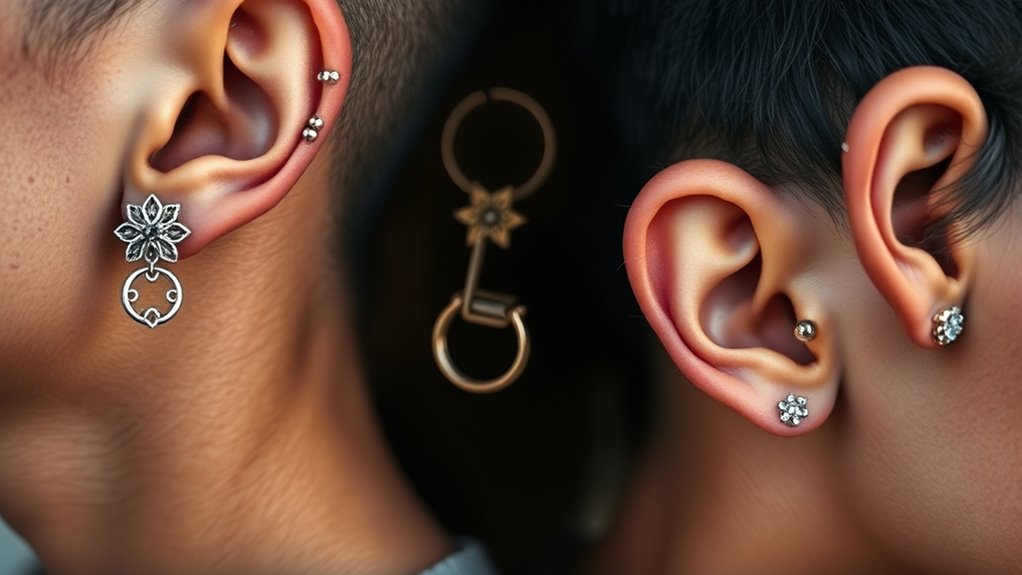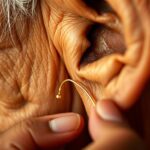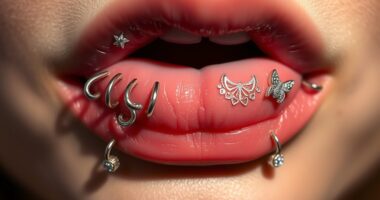Body piercing has a long history rooted in cultural and spiritual traditions, dating back thousands of years. Different societies used piercings to signify status, mark rites of passage, or connect with spiritual beliefs. Over time, these practices evolved from cultural symbols to modern trends, blending tradition with personal expression. Today, piercing is both a form of art and a reflection of identity, rooted in history but constantly adapting. If you continue exploring, you’ll uncover how these ancient customs shape contemporary styles.
Key Takeaways
- Body piercing has ancient origins, symbolizing status, spirituality, or identity across diverse cultures.
- Ritualistic piercings often marked life milestones and connected individuals to spiritual beliefs.
- Over time, piercing evolved from cultural rituals to modern fashion and self-expression trends.
- Advances in safety and jewelry materials have made contemporary piercing more accessible and hygienic.
- Today, piercing blends tradition with personal identity, reflecting both cultural heritage and individual style.

Have you ever wondered what body piercing really involves? At its core, piercing is more than just a fashion statement; it’s a practice rooted in a long and complex history evolution that spans thousands of years. Throughout time, different cultures have used body piercing as a way to symbolize status, spirituality, or identity. For example, ancient Egyptians decorated their ears and noses with jewelry to demonstrate wealth and social standing. In Polynesian societies, facial tattoos and piercings marked rites of passage or tribal affiliations. As you explore the history evolution of piercing, you’ll see that it’s often intertwined with rituals and cultural significance, serving purposes beyond mere adornment. It was a way to connect with spiritual beliefs, mark important life milestones, or distinguish social groups. Over centuries, the reasons behind piercing shifted, yet its cultural importance persisted. In some societies, piercing was believed to offer spiritual protection or ward off evil spirits. In others, it was a rite of passage that signified transition into adulthood. The cultural significance attached to piercings varies widely, but what remains consistent is their role as a form of self-expression and identity.
Fast forward to modern times, and body piercing has evolved into a widespread trend embraced by people worldwide for aesthetic reasons. Today, you can find a plethora of piercing styles, from simple ear lobes to complex cartilage or surface piercings. Advances in sterile techniques and jewelry materials have made piercing safer than ever, encouraging more individuals to participate in this form of self-expression. Despite its modern popularity, many people still appreciate the cultural roots of piercing, often choosing styles that reflect their heritage or personal beliefs. The evolution continues as new trends emerge, blending traditional techniques with contemporary fashion. Whether you’re interested in body piercing for cultural reasons, fashion, or personal symbolism, understanding its history evolution and cultural significance can deepen your appreciation. It’s fascinating to see how a practice so ancient continues to adapt and thrive in today’s society, serving both as a link to the past and a statement of individuality. As you consider your own piercings or appreciate others’, remember that this tradition carries a rich history that shapes its meaning—connecting you with cultures of the past while allowing you to express your unique identity in the present.
Frequently Asked Questions
How Do I Choose a Reputable Piercer?
To choose a reputable piercer, start by checking their piercing safety standards and ensuring they follow strict hygiene protocols. Look for professional credentials, like certifications from recognized health organizations. Read reviews and ask for recommendations to gauge their experience. Visit their studio to see if it’s clean and well-maintained. A reputable piercer prioritizes safety, uses sterile equipment, and makes you feel comfortable throughout the process.
What Are the Most Common Complications?
You should watch out for common complications like allergic reactions, which often happen if jewelry quality isn’t high. Poor quality jewelry can cause irritation, swelling, or infection. Always choose a reputable piercer who uses hypoallergenic materials like surgical steel or titanium. Keep your piercing clean, and avoid touching it with dirty hands. If you notice redness, swelling, or pain, see a professional promptly to prevent further issues.
How Long Does Healing Typically Take?
Healing can feel like an eternity, but typically, it takes about 6 to 8 weeks for your piercing to fully heal. During this healing timeline, follow post-care tips diligently, such as cleaning the area regularly and avoiding irritants. Remember, everyone’s body heals differently, so stay patient and attentive. Proper care guarantees your piercing heals smoothly, preventing complications, and keeps your new adornment looking fabulous for years to come.
Are There Age Restrictions for Piercing?
Age restrictions for piercing vary by location and studio, so check local laws. Generally, minors need parental consent, and some places set minimum ages, often 16 or 18. If you’re under the age limit, you’ll likely require a parent or guardian’s consent and presence. Always verify with your chosen piercing studio beforehand to guarantee compliance with age restrictions and consent policies to avoid issues during the process.
How Can I Minimize Infection Risks?
Imagine you get a new ear piercing; to minimize infection risks, follow proper aftercare tips and maintain piercing hygiene. Clean the area gently twice daily with saline solution, avoid touching it with unwashed hands, and steer clear of irritating products. Keeping your piercing clean and following these aftercare tips helps prevent bacteria buildup, reduces swelling, and speeds healing. Staying vigilant with hygiene is key to avoiding infections and ensuring your piercing heals beautifully.
Conclusion
As you explore body piercing, remember it’s both an ancient ritual and a modern trend. The sacred symbols of past cultures contrast sharply with today’s fashion statements, yet both reveal a desire for self-expression. Whether you see it as tradition or style, piercing remains a powerful way to communicate identity. Embrace its history and innovation, knowing that beneath the surface, it’s about more than aesthetics — it’s about celebrating what makes you uniquely you.
Piecing together a life one day at a time, that’s me. I’m Rusty, and I love being editor-in-chief of creative piercing. It’s my passion to help others see their vision and bring it to life. When I’m not working or taking care of my family, you can find me reading a good book or eating pie (of course!).

















